October 1, 2013
by Carole Zangari -

AAC Awareness Month is something worth celebrating. From the amazing clients we get to work with, to the professionals who put their hearts into this work, to the families who make real change possible, to the researchers and scholars who give us evidence on which to base our practices, to the wonderfully supportive community of manufacturers and developers, AAC is a wonderful field. It’s time for a prAACtical celebration! Thanks to the generosity of a lot of companies and individuals, we’re hosting our second annual AAC Awareness Month Giveaways with drawings on October 9th and 30th. As you can see, we’ve had prizes donated from many wonderful people and organizations: Ablenet, Inc Abilipad Alexicom BeeVisual/ChoiceWorks Dynavox/Mayer Johnson Handhold Adaptive Hump Software MarbleSoft Mozzaz News-2-You Paul H. Brookes Publishing Company Safe N Sound Mobile Silver Lining Multimedia Smarty Ears Speak For Yourself SpeechPathology.com SpeechTree TapSpeak TherapyBox/TBoxApps TouchChat Verbally How Does It... [Read More...]
Filed under: PrAACtical Thinking
September 30, 2013
by Robin Parker -
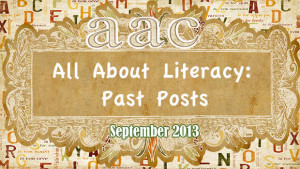
We say goodbye to International Literacy Month. It’s time to move on…. to International AAC Month (exciting things to come 😉 ). But, just in case you missed any of our past posts about literacy, here they are all together. Reasons to Discover & Love MeeGenius 5 Ways to Help People with AAC Needs Develop Inner Speech 5+ Sites for Free AAC Friendly Literacy Resources Making Decisions About Reading Accessibility Options Loving Literacy Resources Making Libraries Inclusive 5 Things We Love for Supporting Literacy Learning by People Who Use AAC 5 Ways to Make Page Fluffers & Spacers 14 Valentines Day Activities:m Love, Literacy, & Learning The Joy of Reading: World Book Day 5 More Resources and Ideas for World Book Day Literacy, AT,, & Students with Significant Disabilities PrAACtically Ready to Read 7 Apps and Activities for ALL Writers Literacy For All: A Video Series by Dr. Caroline Musselwhite... [Read More...]
Filed under: PrAACtical Thinking
Tagged With: Apps, literacy, reading, writing
September 27, 2013
by Robin Parker -
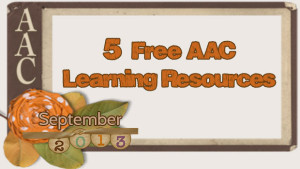
Learn with the Experts Anytime and Any Place Ablenet Professional Development– Ablenet provides free live and recorded webinars by experts in various areas of AAC. The topics range from helping add assistive technology (AT) into IEP’s, to Apps & AAC, to literacy, and much much more. Special Education Technology British Columbia Learning Centre– A variety of recorded webinars on a wide range of AAC topics. The RERC on Communication Enhancement– A variety of recorded webinars about a variety of AAC topics. Augmentative and Alternative Communication Webinar- Autism Speaks– This webinar was recorded in 2012 but focuses on AAC & Autism. Working Without Words: AAC & Technology in the Workplace by Florida Center for Inclusive Communities– Provides an overview of AAC and its applicability in the workforce. Strategies for supporting AAC users and people using AAC in the workplace will be highlighted. Florida Center for Inclusive Communities also offers a variety of... [Read More...]
Filed under: PrAACtical Thinking
Tagged With: Learning, webinars
September 26, 2013
by Robin Parker -
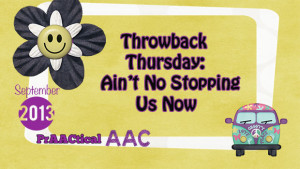
(updated/original version published on October 20, 2012) Sometimes saying ‘no’ to the demands of the day actually helps us rejuvenate and allows us to be more productive. Saying ‘no to false information helps us to advocate for ourselves. The ‘no’ topic seems to be trending now. There have been quite a few blog posts and comments about the issue (Just Say No, How and When to Give Your Students A Break). We are so glad that this topic is getting more focus. Of course everyone agrees that ALL people have the right to say ‘no’. But it is not always so simple. There are many types of ‘no’. There is the outright ‘no’, the ‘no’ to more work, the ‘no’ for disagreement, the ultra important ‘NO’ to unwanted touching, and many more. And depending upon how you say ‘no’ is the difference between it being accepted or… NOT. The issue... [Read More...]
Filed under: PrAACtical Thinking
Tagged With: protesting
September 25, 2013
by Carole Zangari -
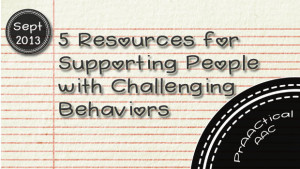
Need some help or new ideas for working with people who have challenging behaviors? Here are some resources to explore. 1. The Challenging Behavior Foundation is a UK-based organization with many good resources. You can check the archives of their newsletters here. 2. Wonderful instructional module on Functional Communication Teaching on the Autism Training Modules website. It takes time to work through this, but the information makes it worth the trouble. You may have to register (free) the first time you visit the site. 3.The National Professional Development Center on ASD has great information on Functional Communication Teaching, an approach with a strong evidence base. 4. The Functional Behavior Assessment Worksheet by PaTTAN 5. Our Pinterest board on Positive Behavior Support
Filed under: PrAACtical Thinking
Tagged With: Challenging Behavior, resources
September 24, 2013
by Robin Parker -
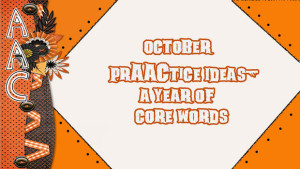
More core word prAACtice ideas. To make core word prAACtice most successful, make sure everyone has access to a core word AAC display and you have some clearly defined communication goals. Then select activities that encourage social interaction, have a shared focus, and are mostly about the process of learning. Build in lots of communication opportunities to use specific target words for both you and the learner. For October, meaningful communication and language activities can include art projects, costume parties with photo’s, gardening/planting, and music/concerts. October has so many great options for fun socially motivating activities that all you have to do is go have fun and model on. OCTOBER WORDS another “another turn” “have another one” “we need another surprise” “We hope he does another song for us” change “change clothes” “please give me change” “I need to change it for the other one” “She will change her mind... [Read More...]
Filed under: PrAACtical Thinking
Tagged With: activity, resource
September 23, 2013
by Robin Parker -
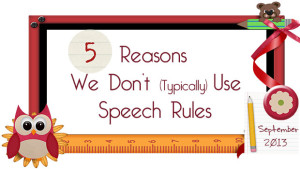
We love organized productive speech therapy sessions. But, we don’t typically use speech rules in our sessions. It’s not that we are inherently against ‘behavior speech rules’ but overall, we don’t use them. Here are some of the reasons why: We use meaningful language activities. We try to use meaningful, fun, and engaging activities so learners want to participate. Even when we think an activity is enjoyable and it is not, it becomes enjoyable and meaningful to “stop” the activity. It is helpful to think about meaningful and fun from the learner’s perspective and not just ours. For example, having a pleasant conversation about awesome pretty pictures would be enjoyable for many students. However, if conversation is difficult, maybe not so much. It’s not that we would not work on conversation, but the activity structure may involve clear beginnings and endings to the conversation, a ‘take home poster’, and/or a... [Read More...]
Filed under: PrAACtical Thinking
Tagged With: boundaries, meaninful language experiences, rules, visual supports
September 20, 2013
by Robin Parker -
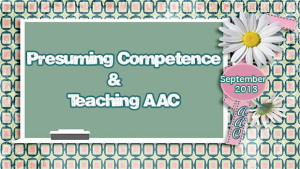
We have said this before, we say it now, and we will say it again because time and time again we are surprised in great ways. Aided Language Input Talk About Relevant Topics Talk About Age-Appropriate Topics Use Language Facilitation Techniques And….Listen to the Message, Be a Communication Partner, Have Fun!
Filed under: PrAACtical Thinking
Tagged With: aided language input, Language facilitation strategies, presume competence
September 19, 2013
by Carole Zangari -
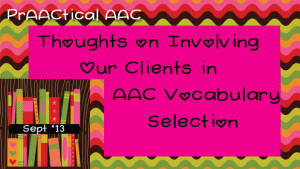
Would you want someone else to pick the car you drive? How happy would you be if someone else selected your wardrobe? How would it feel if the only things you could say were based on words that someone else decided were appropriate for you? Choosing vocabulary is a BIG responsibility. When the client is not fully literate, he/she is constrained to communicating with the words we provide and nothing more. If we left out important concepts, he’s stuck. If we worded the message in a style/tone that doesn’t fit her personality, she’ll be reluctant to use the AAC to communicate. Given this, it makes sense to involve the client in the process of choosing the single words, phrases, sentences, and narratives that we put on the AAC device or in the communication book. If the client is involved, then the messages we end up with are more likely to... [Read More...]
Filed under: PrAACtical Thinking
Tagged With: vocabulary selection
September 18, 2013
by Robin Parker -

Just like reading, everyone needs opportunities to write. We write to make lists, give notes, tell stories, make signs, write letters, show love, vent, remember things, and much more. All students need lots of writing prAACtice and direct instruction. Here are some (just a few) amazing assistive technology options to help writers at all levels of the writing continuum. Picture Symbol Based Clicker Sentences- For emergent writers, students tap words in a grid to build sentences in a simple word processor. Pictures can be added to further increase comprehension of the sentences. Available as computer software with an evaluation option to try it out free for 30 days as well as in an iOS app Abilipad– A fully customizable keyboard and notepad, with word prediction and text-to-speech. This includes setting up a picture based key board. Check out the Abilipad website for more information about all of the possibilities. Kidspiration Maps– a visual way to mind... [Read More...]
Filed under: PrAACtical Thinking
Tagged With: literacy, resources, writing









